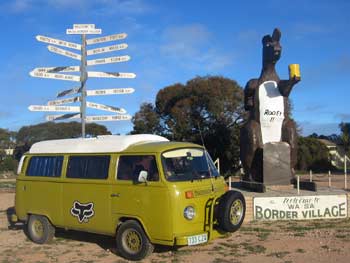Whale-Watching Along The Nullarbor
12th July, Ceduna to Eucla, Australia
At 250,000 square kilometres and 300 metres thick, it is hard to imagine that this slab of limestone, known as The Nullarbor, was once part of the ocean floor. Nullarbor is based on 'nullus arbor', Latin for no trees and there is indeed a stretch where there are no trees, just shrubs - the kind the kangaroos love.
It took John Eyre, the first European explorer, five months to complete the East-to-West crossing back in 1841. Fortunately, nowadays, the Eyre Highway is well surfaced and the journey from Port Augusta to Perth should take four to five days by car. The drive is surprisingly comfortable, albeit a long one. I don't know what I was expecting before embarking on this journey but I wasn't expecting it to be as well set up for travellers. Fuel stations, accommodation and eateries are at manageable intervals along the way.
As tourists, we took the obligatory photos at the 'look out for camels, wombats and kangaroos' and 'Eastern end of Treeless Plain' road signs. We didn't see any live animals though, just a handful of roo road-kills.

Manda's attempts to blend in with the wildlife were
unsuccessful (spot the ears on the hooded top).
On the plus side, there are small attractions en-route that break the monotony of driving this long distance.
Whale-watching
Between the months of May and October, many Southern Right Whales make the migratory journey to the warmer waters of Australia's southern coast to breed. The reason being that the calves do not have much blubber on them at birth and would not stand a good chance of surviving in the cold Sub-antarctic waters. We hadn't spotted any at Victor Harbor (also on the migratory path and billed as a good whale-watching location) but we had seen on news reports that as many as forty whales had made an appearance at the Head of Bight. This was reported a few weeks ago and today as we approached said location, we had our fingers crossed, hoping to see some.
We were in for a treat - we spotted no less than three whales before we'd even reached the lookout point. In total, we saw ten at close range from the viewing platform at the edge of the cliff, and another ten in the distance. Some people had binoculars, but these were not really needed for those whales closest to us - they were so close that we could clearly see the callosities (the white parasitic growths) on their heads and could hear every rasping noise they made. There were three sets of mothers and calves in amongst our sightings. We watched intently, observing their mannerisms and behaviour. We observed them forcing water out of their blowholes, flapping their fins, poking just their heads above the water (known as 'spy hopping'), lying on their backs (body rolling), lifting their tails up and generally swimming playfully with their calves.
Mother and young - Southern Right Whales, right by the coast line
at Head of Bight, South Australia.
An adult whale slaps the water with its fins.
It was an amazing sight and we could have spent a whole day there just watching them. But we had a timetable to stick to and only stayed for an hour and a half before making tracks again.
Crossing the SA/WA border
After driving 500 kilometres (from Ceduna), we'd arrived at the South Australia and Western Australia border. We went through the mandatory quarantine checks for fruit, veg, honey, nuts, seeds etc but not before posing Ethel in front of yet another 'big thing' - this time it was a kangaroo, holding a beer, welcoming visitors to the border village. Go figure!
"Welcome to the WA/SA Border Village", reads the sign underneath
the big roo.
Old Telegraph Station, Eucla
We ventured deeper into Western Australia - well, another 12 kilometres to a place called Eucla to be precise. Crossing the border gave us another 45 minutes (as we had crossed a date line) so we went to see Eucla's Old Telegraph Station, now almost completely buried by sand dunes. According to the leaflets, Eucla was a busy place in the early 1900s and the telegraph station was at the hub of the town. Eucla was an important link in the chain of relay stations from Esperance to Port Lincoln. But now all that remains are ruins gradually being engulfed by a moving desert.
Crossing the Nullarbor may be considered by some as a challenging thing to do, and there are many locals who have never ventured across (or at least not in anything that doesn't have wings and a couple of jet engines strapped to the side). The boredom of long drives might be too much for some people, it's true, and in summer the sheer heat can take its toll, but for us the drive has been really enjoyable so far. Winter is definitely the best time to cross the Nullarbor, both because of the cooler climate and also because it ties up nicely with the whales' migration. So, while it might be a cliché, we can say that we've had a whale of a time!


